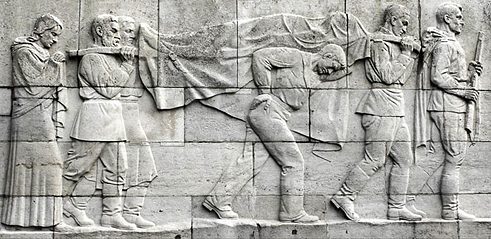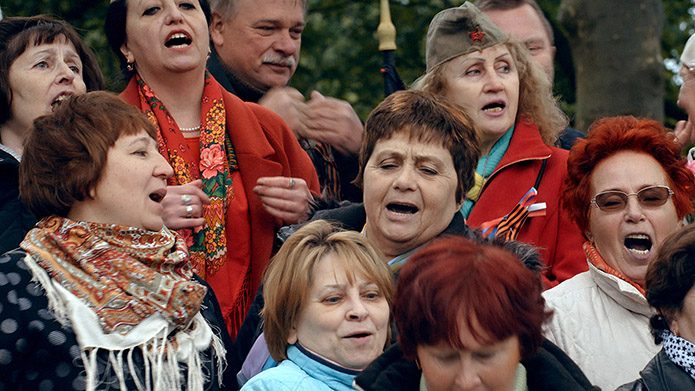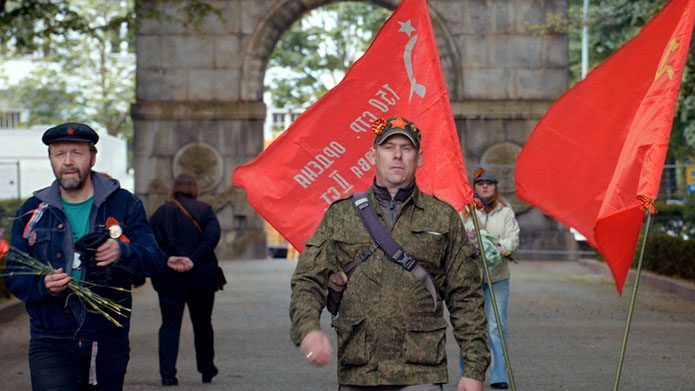MIFF 2018
Victory Day: The art of observation

With ‘Victory Day’, Sergei Loznitsa confirms an idea that his filmography has always favoured: that the art of watching is indeed an art.
As with Austerlitz before it, the Berlin-based Ukrainian director’s latest documentary peers at a place brimming with history and watches the people who walk across the site, turning their reactions into an observational portrait of humanity processing the past.
This time around, Loznitsa trains his cameras towards the Soviet War Memorial and military cemetery in Berlin’s Treptower Park. He films a day of significance not only for the many flocking to its towering stone monument (a structure that he luxuriates in, punctuating the documentary with close-ups of its detailing), but in Russia as well. May 9 is known as Victory Day, commemorating the surrender of Nazi Germany to the Red Army in 1945. The actual act occurred across May 7 to 9 as the formalities were finalised; however it’s the latter date that is still celebrated as a holiday in many parts of the former Soviet Union today. In Berlin, Russians in the city make an annual pilgrimage to the Memorial as though they’re channelling comrades from seven decades prior, in what becomes a mass of song, vodka, views spouted from megaphones and solemn queues to pay respect to the fallen.
A TAPESTRY OF MINUTIAE
Victory Day captures the scenes from May 9, 2017. From all appearances, there’s nothing out of the ordinary about the day’s gathering in comparison to other years. Indeed, as teenagers in uniform march, two terriers lead a flower cart emblazoned with Stalin’s face, and random snippets of conversation are overhead from the largely nondescript crowds — “I am Russian and German,” one voice says — the throngs of attendees couldn’t appear more standard. Some stand grimly and silently, although there’s always an audible buzz to proceedings, even if tunes aren’t being sung and speeches aren’t being made at a given second. Others act out their allegiance to the occasion, whether in chatter, in music, or in carried photographs of the dead. 'Victory Day' captures the scenes from May 9, 2017.
| © Victory Day
As Loznitsa has also highlighted in his other works — including The Event, which looked back at the Soviet August coup of 1991, and Maidan, about the protests in Kiev in 2013 and 2014 — ordinariness often speaks volumes when something extraordinary is occurring. With his current film employing the director’s now-familiar observational methodology, it quickly proves a chronicle of the regular becoming the resonant. He once again places the camera in set spots, records static shots as people go about their business in front of the lens, and offers no explanation either as text or narration. There’s nothing overtly exceptional spied by the filmmaker and fellow cinematographers Diego Garcia and Jesse Mazuch) in the footage that results, but everything that is seen contributes to a specific snapshot. The documentary weaves its sea of people and its parade of moments into a tapestry comprised of those marking history, although just what it means is left to the viewer to interpret for themselves.
'Victory Day' captures the scenes from May 9, 2017.
| © Victory Day
As Loznitsa has also highlighted in his other works — including The Event, which looked back at the Soviet August coup of 1991, and Maidan, about the protests in Kiev in 2013 and 2014 — ordinariness often speaks volumes when something extraordinary is occurring. With his current film employing the director’s now-familiar observational methodology, it quickly proves a chronicle of the regular becoming the resonant. He once again places the camera in set spots, records static shots as people go about their business in front of the lens, and offers no explanation either as text or narration. There’s nothing overtly exceptional spied by the filmmaker and fellow cinematographers Diego Garcia and Jesse Mazuch) in the footage that results, but everything that is seen contributes to a specific snapshot. The documentary weaves its sea of people and its parade of moments into a tapestry comprised of those marking history, although just what it means is left to the viewer to interpret for themselves.
A STATEMENT MADE BY WATCHING
One could glean the abundance of red and conceive a study in long-distance patriotism, or, conversely, could just as easily ingest the solemn tenor across many of the attendees’ faces as a display of communal mourning. Both are true, but Loznitsa is more concerned with showing the audience how humanity interacts with the past rather than making a statement about the significance of Victory Day for those seen in the film. For them, en masse, it’s the act of being there that means something. For the documentary, filing its frames with their actions, it’s watching them that’s the act of artistry and commentary. There’s a knack to sitting and letting the world go by in an almost meditative fashion, viewing without remarking, hearing without speaking, and allowing a picture form simply by bearing witness. There’s a particular skill to focusing a film’s gaze upon a chosen target — a place, a date, a crowd, an occasion — and letting the chips and insights fall where they may. Loznitsa is concerned with showing the audience how humanity interacts with the past.
| © Victory Day
Austerlitz did the same, of course. As tourists walked through the Dachau and Sachsenhausen concentration camps and responded to their surroundings, as well as to the sites’ respective traumatic histories, their reactions said everything at once without saying anything in tandem. Viewers of the film discovered much while looking at little, and — with a weight perhaps now especially appreciated by someone who first saw Austerlitz, then visited Sachsenhausen for themselves — experienced both the heart-wrenching importance of the location and the reality that people grapple with that feeling in a multitude of ways.
Loznitsa is concerned with showing the audience how humanity interacts with the past.
| © Victory Day
Austerlitz did the same, of course. As tourists walked through the Dachau and Sachsenhausen concentration camps and responded to their surroundings, as well as to the sites’ respective traumatic histories, their reactions said everything at once without saying anything in tandem. Viewers of the film discovered much while looking at little, and — with a weight perhaps now especially appreciated by someone who first saw Austerlitz, then visited Sachsenhausen for themselves — experienced both the heart-wrenching importance of the location and the reality that people grapple with that feeling in a multitude of ways.Victory Day is a clear, worthy and engrossing successor, this time interrogating another space filled with the ghosts of ill times in Loznitsa’s adopted base. With so much of Berlin shaped as a perpetual reminder that the Second World War should never be forgotten — let alone much of Germany — long may the filmmaker direct his camera towards the many monuments that mark the period, and long may he capture humanity’s efforts to cope.